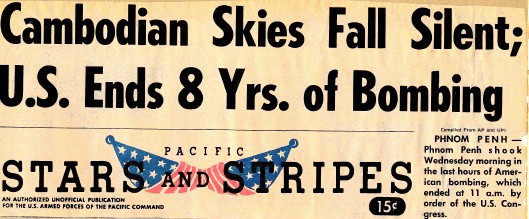Lt. Col. (Ret.) Dick Graham sent these clippings from the Stars and Stripes, Pacific edition, that appeared in the fall of 1972. Dick was an aircraft commander with the 362nd TEWS at Da Nang. A daily newspaper for American armed forces across the world, Stars and Stripes dates from World War I. Stateside newspapers or magazines like Newsweek and Time were fairly common in Vietnam, but by the time they crossed the Pacific and wound through the in-country mail system, the news content was very old indeed. Stars and Stripes was generally available to the troops within a day or so of publication; even sooner at a major urban base such as Tan Son Nhut or Da Nang.

Although published by the Department of Defense, the paper maintained editorial independence—so much so in fact that Gen. Creighton Abrams, who succeeded Westmoreland as COMUSMACV, occasionally expressed his displeasure at the paper's slant on a particularly story.* Despite its supposedly highly classified mission, the Electric Goon occasionally made the news.
Click on the thumbnails to view full-size images.
In reference to the "Red Rocket Barrage" clipping, Dick says he was preflighting one of the three damaged EC-47 "spy planes" when it was hit.
| |
__________
* See, for example, Lewis Sorley, Vietnam Chronicles. The Abrams Tapes, 1968-1972 (Texas Tech Univ. Press, 2004), p. 24.
* * * * *
A little later, Dick sent another clipping, along with a brief explanation. Click on the thumbnail for full-size image.
My association with the EC-47 officially ended when I left DaNang and the 362nd TEWS in September of 1972. My next assignment was as a KC-135 copilot at Travis AFB, CA. After the cease fire in April of ’73, my family and I were part of the crowds at Travis cheering our POWs arrival as part of Operation Homecoming.
While US combat forces had left South Vietnam, there was still a war going on over Laos and Cambodia. Thus, despite being home for less than a year, June found me winging across the Pacific to re-join the Southeast Asian War Games. Instead of DaNang or NKP, I was sent to U Tapao AB near Bangkok. For the next month and a half, my crew was flying almost daily, refueling fighters on bombing missions supporting Cambodian government troops trying to prevent a communist takeover of the country. This all changed on August 16th, 1973 when Congress ordered all offensive bombing mission stopped ending over eight years of air strikes in Southeast Asia.
The attached article from The Stars and Stripes describes the situation as the “skies went silent” over Cambodia. Buried deep, near the end of the article is the comment “We will continue to fly unarmed and unescorted reconnaissance missions over Cambodia.” I wonder who might have been flying most of those unarmed and unescorted recon missions?
Richard “Dick” Graham
Article updated 11 April 2020

